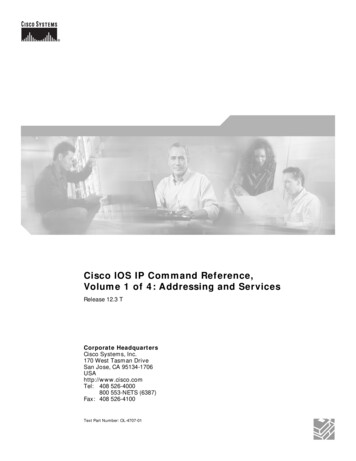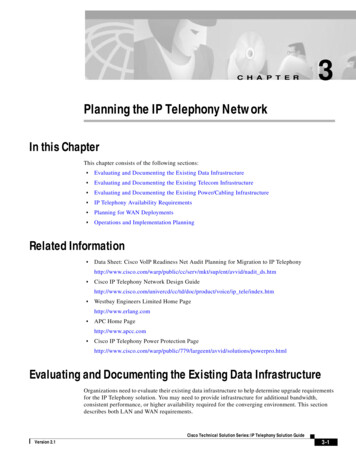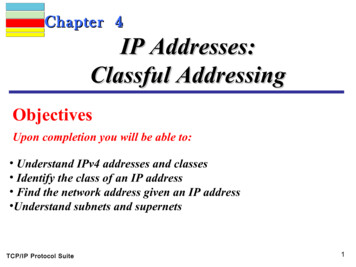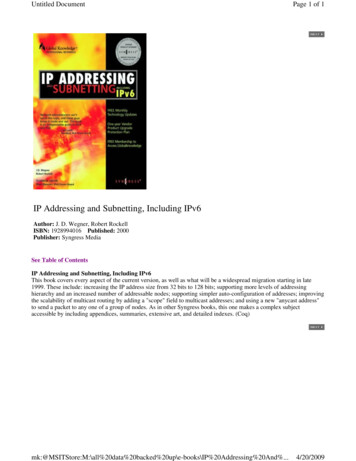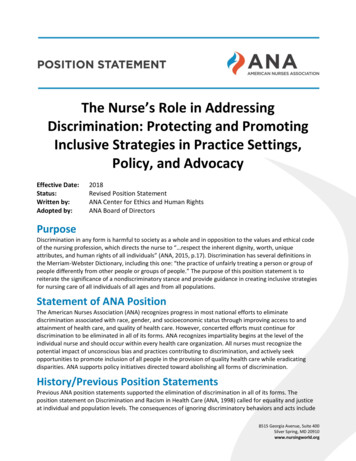
Transcription
The Nurse’s Role in AddressingDiscrimination: Protecting and PromotingInclusive Strategies in Practice Settings,Policy, and AdvocacyEffective Date:Status:Written by:Adopted by:2018Revised Position StatementANA Center for Ethics and Human RightsANA Board of DirectorsPurposeDiscrimination in any form is harmful to society as a whole and in opposition to the values and ethical codeof the nursing profession, which directs the nurse to “ respect the inherent dignity, worth, uniqueattributes, and human rights of all individuals” (ANA, 2015, p.17). Discrimination has several definitions inthe Merriam-Webster Dictionary, including this one: “the practice of unfairly treating a person or group ofpeople differently from other people or groups of people.” The purpose of this position statement is toreiterate the significance of a nondiscriminatory stance and provide guidance in creating inclusive strategiesfor nursing care of all individuals of all ages and from all populations.Statement of ANA PositionThe American Nurses Association (ANA) recognizes progress in most national efforts to eliminatediscrimination associated with race, gender, and socioeconomic status through improving access to andattainment of health care, and quality of health care. However, concerted efforts must continue fordiscrimination to be eliminated in all of its forms. ANA recognizes impartiality begins at the level of theindividual nurse and should occur within every health care organization. All nurses must recognize thepotential impact of unconscious bias and practices contributing to discrimination, and actively seekopportunities to promote inclusion of all people in the provision of quality health care while eradicatingdisparities. ANA supports policy initiatives directed toward abolishing all forms of discrimination.History/Previous Position StatementsPrevious ANA position statements supported the elimination of discrimination in all of its forms. Theposition statement on Discrimination and Racism in Health Care (ANA, 1998) called for equality and justiceat individual and population levels. The consequences of ignoring discriminatory behaviors and acts include8515 Georgia Avenue, Suite 400Silver Spring, MD 20910www.nursingworld.org
an ever-increasing gap in health disparities and negation of our professional values. ANA position statementon The Nurse’s Role in Ethics and Human Rights (ANA, 2016) provided additional documentation in supportof eliminating discrimination based upon the ethical obligations of nurses as outlined in the Code of Ethicsfor Nurses with Interpretive Statements. Numerous recommendations are outlined in the 2016 positionstatement with implications for individual nurses, the nursing profession, nursing education, nursingresearch, and health care organizations. This ANA position statement upholds previous position statementsby denouncing discrimination of any kind.Supportive MaterialDiscrimination exists when a person is treated unfavorably or unjustly according to a particular characteristicsuch as race, age, gender, or religion. There are many other characteristics for which discrimination canoccur. For example, discrimination can occur on the basis of pregnancy, political affiliation, or militarystatus. The list goes on and may change over time. To illustrate, we now recognize that family medicalhistory and genetic testing can be used as a basis for discrimination. Attitudes and beliefs about personalcharacteristics in the forms of bias, prejudice, and stereotyping may influence behavior, but the actual act ofdiscrimination, also known as intentional or blatant discrimination, occurs when an individual or group actsupon those attitudes and beliefs (Black, Johnson, & VanHoose, 2015; Gee & Ro, 2009). This form ofdiscrimination may be manifested as microaggressions in the form of a microassault. Implicit orunintentional discrimination can be as detrimental as intentional discrimination, although it resides outsideof the perpetrator’s awareness (Bertrand, Chugh & Mullainathan, 2005). Manifestations of unintentionaldiscrimination in the form of microaggressions are unconscious behaviors considered to be rude,demeaning, or damaging to the individual or group. These microaggressions are further classified asmicroinsults and microinvalidations that disavow the experiences or beliefs of a group (Holley, Tavassoli, &Stromwall, 2016; Sue, 2010). For example, when negative stereotypes are expressed about men in nursing,male nurses may experience microinsults or microinvalidations (Brody et al., 2017).Perceived DiscriminationWhen individuals believe that they have experienced discrimination based on personal characteristics, theymay exhibit poorer physical and psychological health (Sutin, Stephan, &Terracciano, 2015). The link betweenperceived discrimination, racism, and health, including mental health, chronic health conditions, andpersonality development, has been a focus for greater understanding of health disparities among ethnicgroups. The effects of perceived discrimination can affect the outcomes of health care, as those reportingthis type of discrimination believe they are not receiving optimal care, may delay treatment, have difficultyadhering to treatment plans, and may experience internalized racism, creating ongoing stressors thatfurther affect health status (Blendon et al., 2007; Carlisle, 2015; Williams, 2012). While some researchershave suggested that health disparities are due to socioeconomic status (SES), other researchers have foundthat disparities continue even when socioeconomic factors are taken into account. That is, regardless of SES,African Americans continue to be at greater risk for hypertension as well as other metabolic disease (Monk,2015).Health DisparitiesThe delivery of health care has long been associated with discrimination, either perceived on the part of thepatient or actual or inadvertent on the part of the provider or institution (Reynolds, 2004). Hastert (2016)reported that the discrimination and resulting inequities in health outcomes were not related to income butto demographics, specifically race and ethnicity. However, Brooks et al. (2017) and Link et al. (2017) diddemonstrate both a race/ethnic and socioeconomic impact on health and health outcomes. The grouping ofthese health outcomes is commonly referred to as health disparities (Lee, Ayers, & Kronenfeld, 2009).Stuber, Meyer, and Link (2008) suggested that stigma be included with prejudice as perceived causes ofdiscrimination, and therefore poor health outcomes. Pascoe and Richman’s (2009) meta-analysis describedthe negative impact of a patient’s perceptions of discrimination regarding health care delivery on thatPage 2The Nurse’s Role in Addressing Discrimination: Protecting and Promoting InclusiveStrategies in Practice Settings, Policy, and Advocacy8515 Georgia Avenue, Suite 400Silver Spring, MD 20910www.nursingworld.org
patient’s actual health outcomes. Lee, Ayers, and Kronenfeld (2009) described how perceptions ofdiscrimination led to a delay in seeking health care, resulting in poor health outcomes. Burgess et al. (2008)described an immense web of factors, including actual variations of illness among demographic groups,access to health care, and health care funding policies as reasons for health disparities.ANA takes the position that it does not matter if an individual’s demographic is expected to have a higherincidence of illness. All patients should equally be screened for all health risk factors, including but notlimited to elevated blood pressure, elevated blood glucose, HIV, changes in visual and hearing capacity, andproper body mass index; provide all applicable cancer screenings and mental health screenings; and receiveall preventive health services, such as vaccinations.Finally, ANA takes the position that discrimination has no place in nursing practice, education, or research. Ithas no place in health care. All patients are equal and should be treated with impartiality, respect, andcivility. Civility is an active behavior that embodies mutual respect, promotes communication, and fosterscollaboration among nurses and patients and the health care team (Lower, 2012). ANA takes the positionthat treating the illness or injury is important and the demographic or socioeconomic status should notinfluence the level of care provided. ANA takes the position that organizational policy that inadvertentlysupports discrimination is in error. It does not matter if it is an organization’s policy that discriminates or apolicy in support of individual employees who discriminate; it is wrong and needs to be stopped.RecommendationsANA recommends implementation of the following activities: Intentional or blatant discriminatory practices must not be tolerated and must be immediatelyaddressed. Nurses must engage in a period of self-reflection regarding their personal and professionalvalues regarding civility, mutual respect, and inclusiveness, and resolve any potential conflicts inways that ensure patient safety and promote the best interests of the patient (ANA, 2015). Nurses must seek out and support nursing practice environments that embrace inclusivestrategies and promote civility and mutual respect regarding patients, coworkers, and members ofthe community. Nurses must advocate for policies that are inclusive and promote civility and human rights for allhealth care workers, patients, and others within the organization and community. Nurses must encourage all health care agencies to adopt and aggressively maintain policies,procedures, and practices that embrace inclusiveness, promote civility and mutual respect, containmethods for reporting violations, and require interventions to avoid recurrence. Nurses must work both within the profession and with other health care professionals, socialworkers, clergy, and advocacy organizations to create diverse, inclusive communities that promote,protect, and sustain high-quality, effective, efficient, and safe health care practices (ANA, 2010). Nurses in all environments and at all levels must embrace the concepts of justice and caring,diversity and inclusiveness, and civility and mutual respect as guiding principles within the provisionof health care. Nurse researchers must support and conduct research that is inclusive in nature, includingdiverse populations and their health care needs. Nurse managers, supervisors, and administrators must assess policies to ensure support ofinclusiveness, civility, and mutual respect, acknowledging that the lack of such policies may result inPage 3The Nurse’s Role in Addressing Discrimination: Protecting and Promoting InclusiveStrategies in Practice Settings, Policy, and Advocacy8515 Georgia Avenue, Suite 400Silver Spring, MD 20910www.nursingworld.org
environments that fail to sustain high-quality, effective, efficient, and safe health care practices(ANA, 2010). Nurse educators must promote a diverse workforce by developing education practices to attractand retain students from all backgrounds. An increased number of diverse nurses in the workforcewill begin to reflect the diversity of the overall population in the United States (Graham, Phillips,Newman, & Atz, 2016). Nurses must embrace a patient-centered approach responsive to the individual cultural needsand concerns of their patients and families (Cuevas, O’Brien, & Saha, 2017).SummaryDiscrimination continues to affect the health of populations. Discriminatory practices that are eitherintentional or unintentional must be addressed by individual nurses and the profession as a whole. Giventhe impact of unintentional discrimination based upon attitudes and stereotyping, all nurses must examinetheir biases and prejudices for indications of discriminatory actions. Health disparities continue to exist andare influenced by health policies, individual discriminatory actions, marginalization, and perceiveddiscrimination by the affected population. The nursing profession is responsible for promoting anenvironment of inclusiveness where all receive safe, quality care, and caregivers are intolerant of anydiscriminatory practice.ReferencesAmerican Nurses Association. (1998). Discrimination and racism in health care. Retrieved rican Nurses Association. (2010). Nursing’s social policy statement: The essence of the profession (10th Ed.). Silver Spring,MD: nursesbooks.orgAmerican Nurses Association. (2015). Code of ethics for nurses with interpretive statements. Silver Spring, MD:nursebooks.org.American Nurses Association. (2016). The nurse’s role in ethics and human rights: Protecting and promoting individual worth,dignity, and human rights in practice settings. Retrieved from urses-role-in-ethics-and-human-rights/Bertrand, R., Chugh, D., & Mullainathan, S. (2005). Implicit discrimination. The American Economic Review, 95(2), 94-98.Black, L. L., Johnson, R. & VanHoose, L. (2015). The relationship between perceived racism/discrimination and health amongblack American women: A review of the literature from 2003-2013. Journal of Racial and Ethnic Disparities, 2, 11-20.doi: 10.1007/s40615-014-0043-1Blendon, R. J., Buhr, T., Cassidy, E. F., Perez, D. J., Hunt, K.A., Fleschfresser, C., Herrmann, M. J. (2007). Disparities in health:Perspectives of a multi-ethnic, multi-racial America. Health Affairs, 26(5), 1437-1447. doi: 10.1377/hlthaff.26.5.1437Brody, A. A., Farley, J. E., Gillespie, G. L., Hickman, R., Hodges, E. A .Pesut, D.J. (2017). Diversity dynamics: The experience ofmale Robert Wood Johnson Foundation nurse faculty scholars. Nursing Outlook, 65, 278-288.Brooks, C. J., Gortmaker, S. L., Long, M. W., Cradock, A. L., & Kenney, E. L. (2017). Racial/ethnic and socioeconomic disparitiesin hydration status among US adults and the role of tap water and other beverage intake. American Journal of PublicHealth, 107, 1387-1394. doi: 10.2105/AJPH.2017.303923Carlisle, S. K. (2015). Perceived discrimination and chronic health in adults from nine ethnic subgroups in the USA. Ethnicity &Health, 20(3), 309-326. doi: 10.1080/13557858.2014.921891Page 4The Nurse’s Role in Addressing Discrimination: Protecting and Promoting InclusiveStrategies in Practice Settings, Policy, and Advocacy8515 Georgia Avenue, Suite 400Silver Spring, MD 20910www.nursingworld.org
Cuevas, A. G., O’Brien, K. & Saha, S. (2017). What is the key to culturally competent care: Reducing bias or cultural tailoring?Psychology & Health, 32(4), 493-507. doi: 10.1080/08870446.2017.1284221Gee, G. C. & Ro, A. (2009). Racism and discrimination. In C. Trinh-Shevrin, N.S. Islam & M.J. Rey (Eds.), Asian Americancommunities and health: Context, research, policy, and action. San Francisco, CA: Jossey-Bass.Graham, C. L., Phillips, S. M., Newman, S. D. & Atz, T.W. (2016). Baccalaureate minority nursing students perceived barriersand facilitators to clinical education practices: An integrative review. Nursing Education Perspectives, 37(3), 130-137.doi: 10.1097/01.NEP.0000000000000003Hastert, T. A. (2017). All dollars are not created equal: Health disparities persist even among the highest income Americans.Preventive Medicine, 96, 154-155. y, L. C., Tavassoli, K.Y. & Stromwall, L. K. (2016). Mental illness discrimination in mental health treatment programs:Intersections of race, ethnicity, and sexual orientation. Community Mental Health, 52, 311-322. doi: 10.1007/s10597016Lee, C., Ayers, S. L., & Kronenfeld, J. J. (2009). The association between perceived provider discrimination, health careutilization, and health status in racial and ethnic minorities. Ethnicity & Disease, 19(3), 330.Link, B. G., Susser, E. S., Factor-Litvak, P., March, D., Kezios, K. L., Lovasi, G. S.,.Johnson, E. (2017). Disparities in self-ratedhealth across generations and through the life course. Social Science & Medicine, 174, 17-25. doi:10.1016/j.socscimed.2016.11.035 9990-9Lower, J. (2012). Civility starts with you. American Nurse Today, 7(5). 21-22.McGuire, T. G., & Miranda, J. (2008). New evidence regarding racial and ethnic disparities in mental health: Policyimplications. Health Affairs, 27(2), 393-403. doi: 10.1377/hlthaff.27.2.393Monk, E .P. (2015). The cost of color: Skin color, discrimination, and health among African-Americans. American Journal ofSociology, 121(2), 396-444.Reynolds, P. P. (2004). Professional and hospital discrimination and the US Court of Appeals Fourth Circuit 1956–1967.American Journal of Public Health, 94(5), 710-720. Retrieved 448322/Streed, C. G., McCarthy, E. P., & Haas, J. S. (2017). Association between gender minority status and self-reported physical andmental health in the United States. JAMA Internal Medicine, 177(8):1210-1212. doi:10.1001/jamainternmed.2017.1460710-720.Sue, D.W. (2010). Microaggressions in everyday life: Race, gender, and sexual orientation. Hoboken, NJ: Wiley.Sutin, A., Stephan, Y. & Terracciano, A. (2016). Perceived discrimination and personality development in adulthood.Developmental Psychology, 52(1), 155-163. doi: 10.1037/dev000069Williams, D. R. (2012). Miles to go before we sleep: Racial inequities in health. Journal of Health and Social Behavior, 53(3),279-295. doi: 10.1177/0022146512455804ANA acknowledges Michele Upvall, PhD, RN, CNE, FAAN and Thomas Ray Coe, PhD, MBA, MHA,MS, RN-BC, NEA-BC, FACHE who contributed to the drafting of this document on behalf of theANA Ethics Advisory Board.Page 5The Nurse’s Role in Addressing Discrimination: Protecting and Promoting InclusiveStrategies in Practice Settings, Policy, and Advocacy8515 Georgia Avenue, Suite 400Silver Spring, MD 20910www.nursingworld.org
The American Nurses Association (ANA) recognizes progress in most national efforts to eliminate discrimination associated with race, gender, and socioeconomic status through improving access to and attainment of health care, and quality of health care. However, concerted efforts must continue for discrimination to be eliminated in all of its forms.






